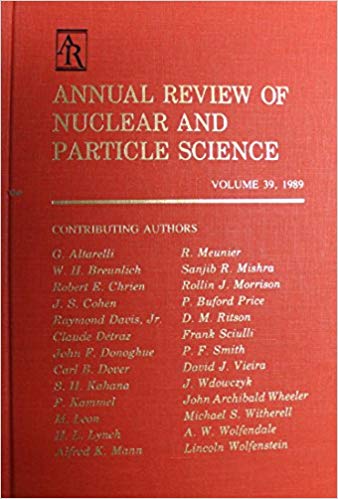我们能从$\mathcal {N}=4$ Super Yang-Mills中学到什么关于QCD和对撞机物理?
IF 8.4
2区 物理与天体物理
Q1 PHYSICS, NUCLEAR
Annual Review of Nuclear and Particle Science
Pub Date : 2020-05-30
DOI:10.1146/annurev-nucl-102819-100428
引用次数: 18
摘要
大量正在进行的理论工作致力于开发量子色动力学(QCD)计算的新方法。要充分利用在大型强子对撞机上仍有待收集的数据,需要的是定性的而不是渐进式的进展。最大超对称Yang-Mills理论,=4超级Yang-Mills (sYM),与QCD共享胶子扇区,它包含最复杂的费曼图,但也有许多特殊的性质,并且被认为是精确可解的。很自然地要问我们可以从解决QCD中的难题的改进中学习到什么。考虑到这一点,我回顾了几个显著的发展和最近结果的亮点,包括某些散射振幅的全阶结果,新的对称性,环路积分的惊人几何结构,计算费曼积分的新工具,以及自举方法。虽然一些见解和工具已经被转移到QCD中,并为LHC物理的最先进计算做出了贡献,但我认为还有许多更吸引人的想法有待探索。预计《核与粒子科学年鉴》71卷的最终在线出版日期为2021年9月。修订后的估计数请参阅http://www.annualreviews.org/page/journal/pubdates。本文章由计算机程序翻译,如有差异,请以英文原文为准。
What Can We Learn About QCD and Collider Physics from $\mathcal {N}=4$ Super Yang–Mills?
Tremendous ongoing theory efforts are dedicated to developing new methods for quantum chromodynamics (QCD) calculations. Qualitative rather than incremental advances are needed to fully exploit data that are still to be collected at the LHC. The maximally supersymmetric Yang–Mills theory, 𝒩=4 super Yang–Mills (sYM), shares with QCD the gluon sector, which contains the most complicated Feynman graphs but also has many special properties and is believed to be solvable exactly. It is natural to ask what we can learn from advances in 𝒩=4 sYM for addressing difficult problems in QCD. With this in mind, I review several remarkable developments and highlights of recent results in 𝒩=4 sYM. This includes all-order results for certain scattering amplitudes, novel symmetries, surprising geometrical structures of loop integrands, novel tools for the calculation of Feynman integrals, and bootstrap methods. While several insights and tools have already been carried over to QCD and have contributed to state-of-the-art calculations for LHC physics, I argue that there is a host of further fascinating ideas waiting to be explored. Expected final online publication date for the Annual Review of Nuclear and Particle Science, Volume 71 is September 2021. Please see http://www.annualreviews.org/page/journal/pubdates for revised estimates.
求助全文
通过发布文献求助,成功后即可免费获取论文全文。
去求助
来源期刊
CiteScore
21.50
自引率
0.80%
发文量
18
期刊介绍:
The Annual Review of Nuclear and Particle Science is a publication that has been available since 1952. It focuses on various aspects of nuclear and particle science, including both theoretical and experimental developments. The journal covers topics such as nuclear structure, heavy ion interactions, oscillations observed in solar and atmospheric neutrinos, the physics of heavy quarks, the impact of particle and nuclear physics on astroparticle physics, and recent advancements in accelerator design and instrumentation.
One significant recent change in the journal is the conversion of its current volume from gated to open access. This conversion was made possible through Annual Reviews' Subscribe to Open program. As a result, all articles published in the current volume are now freely available to the public under a CC BY license. This change allows for greater accessibility and dissemination of research in the field of nuclear and particle science.

 求助内容:
求助内容: 应助结果提醒方式:
应助结果提醒方式:


